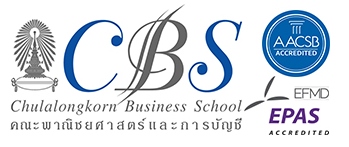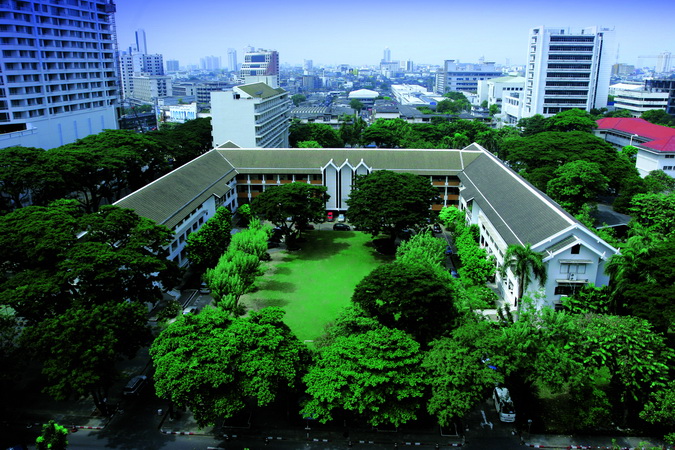
Brief History of Chulalongkorn Business School (CBS)
Chulalongkorn Business School is a leading educational institution that produces the finest quality graduates to contribute to Thailand's business society for a long time. CBS has developed business education to compete with world's leading universities. CBS has continued to develop its students and encouraged faculty members to originate intellectual contributions. Moreover, CBS has built up the fundamental educational structure that will be the solid foundation for further development. These developments are the result of the vision of CBS's founder and the first dean, Professor Phraya Chaiyotsombat. Chulalongkorn University issued an order no. 23/2158 on October 22, 1938 to set up the Accountancy and Commerce program. Later on, the Accountancy and Commerce program became an independent program on May 4, 1940. Also, the following honorary committee members were appointed to create the business curriculum structure:
|
1. Phraya Chaiyotsombat
|
Committee Chairman
|
|
2. Pra Manupanvimonsart
|
Committee
|
|
3. Luang Propittayapayat
|
Committee
|
|
4. Aporn Kritsanamara
|
Committee
|
|
5. Siri Huntrakul
|
Committee
|
|
6. Sukit Nimmanhemin
|
Committee and Secretary
|
Professor Phraya Chaiyotsombat was appointed to be the head of the Accountancy and Commerce program on May 4, 1940. Academic committee decided to make the curriculum independent and different from Faculty of Arts and Science's. As a result, Accountancy students were required to study the theoretical part for 4 years and the practical part for 1 year. Later in 1944, the program removed the practical part from the curriculum. Consequently, Accountancy students were required to study only the theoretical part for 4 years. After graduation, they would receive a degree in 'Bachelor of Accountancy.' For the Commerce program, students were required to study for 4 years. After graduation, they would receive a degree in 'Bachelor of Commerce.
Curricula
For the past 70 years of business education, CBS has developed curricula to fulfill the country's needs in business and industry. Accordingly, new business educational programs have been added continually. Additionally, CBS has continued to improve the curricula to be up-to-date all the time. At present, CBS has curricula at all educational levels to support the expansion of education in the future as the following:
Undergraduate Level
| 1939 | Bachelor of Accountancy |
| Bachelor of Business Administration | |
| 1957 | Bachelor of Science in Statistics |
| 1939 | Bachelor of Business Administration in Banking and Finance |
| 1939 | Bachelor of Business Administration in Marketing |
| 1996 | Bachelor of Business Administration (International Program) |
| Master's Degree Level | |
| 1982 | Master of Business Administration |
| 1986 | Master of Business Administration (Non-Official Hours Program) |
| 1992 | Master of Science in Information Technology in Business |
| Master of Science in Information Technology in Business (Non-Official Hours Program) | |
| Master of Science in Insurance | |
| 1993 | Master of Accountancy (Non-Official Hours Program) |
| 1997 | Master of Science in Finance |
| 1999 | Master of Science in Finance (Non-Official Hours Program) |
| 2003 | Master of Science in Business Software Development |
| 2004 | Master of Management in International Business (International Program) |
| 2006 | Master of Science in Corporate Governance |
| Master of Science in Marketing | |
| Master of Business Administration in Aviation Management | |
| Master of Business Administration (English Program) | |
| 2008 | Master of Business Administration in Hospital and Health Care Management |
| 1988 | Doctor of Philosophy in Accountancy |
| 1991 | Joint Doctoral Program in Business Administration (Chulalongkorn University, Thammasat University, and National Institute of Development Administration) |
| 2004 | Doctor of Philosophy in Information Technology in Business |
| 2008 | Doctor of Philosophy in Quantitative Finance (English Program) |
Instructors
In academic year 1939, which was the first semester, CBS had only 2 full-time instructors. From that point on, the number of instructors has continued to increase. As a result, in academic year 2008, CBS had 130 full-time instructors. There were more than 72 instructors with doctoral degrees, calculating as 55.38 percent of the entire faculty. Compared with the entire number of undergraduate and graduate students, the ratio was 1 instructor per 45 students.
Buildings
During the first period, CBS had management offices and study rooms in some part of Faculty of Arts' building. Later in 1944, CBS received a budget for a study building. However, during the time of World War II, CBS could not build a large building. Thus, CBS built a temporary thatch-roofed wooden house that was regarded as the first study place of CBS, beside Faculty of Arts' building. At that time, the students called this CBS study place as 'Light Blue Cottage.' Although it was just a thatch-roofed cottage, all of the students were very proud of their building. In 1949, the government approved a budget 1 million baht to build the first permanent study building beside the old library building. (Thereafter, CBS transferred the ownership of the building to the Faculty of Arts.) Later on, the number of students increased, creating the needs of more study areas. To solve the problem, Professor Phraya Chaiyotsombat asked the university for a piece of land of about 25 Rai (about 10 acres), and the university approved CBS's request. Moreover, CBS asked the government to issue the act of legislation in expropriate a piece of land to build a new study building. In 1959, CBS received a budget for new study buildings: Chaiyotsombat Building Numbers 1, 2, and 3. Later on, Bandit Kantabutra Building, which has become a computer center, was built in 1962. The expansion of new curricula, management of the school to respond to the economic situations and society, and changes in academic matters encouraged CBS to build more study buildings. At the 50th Anniversary, CBS built the 50th Anniversary Memorial Building (an 8-story building). Presently, there is also the Mahitaladhibesra Social Science Complex Building which was built on the old land of CBS's Building Numbers 4 and 5, and the former Statistical Conference Room.




